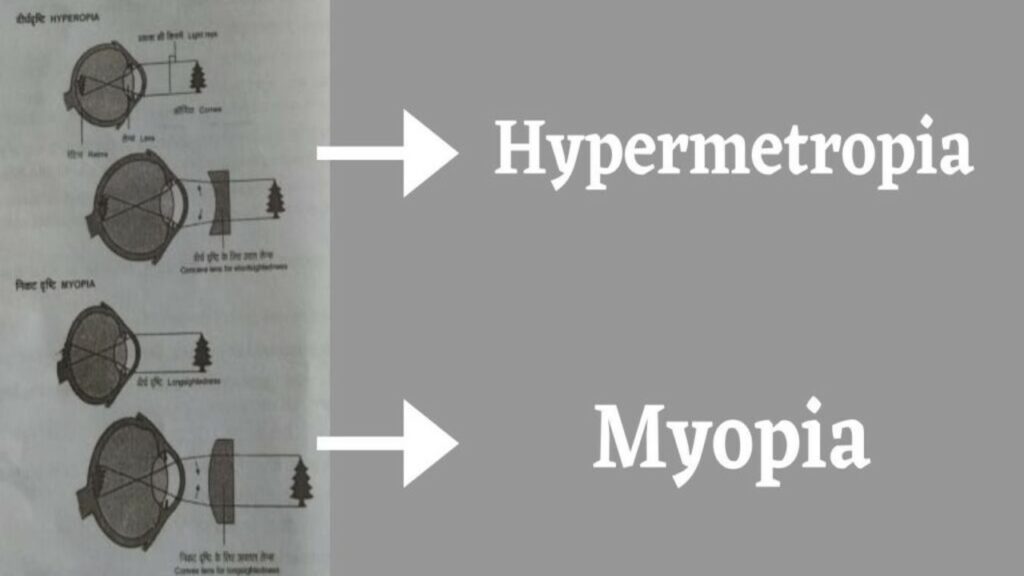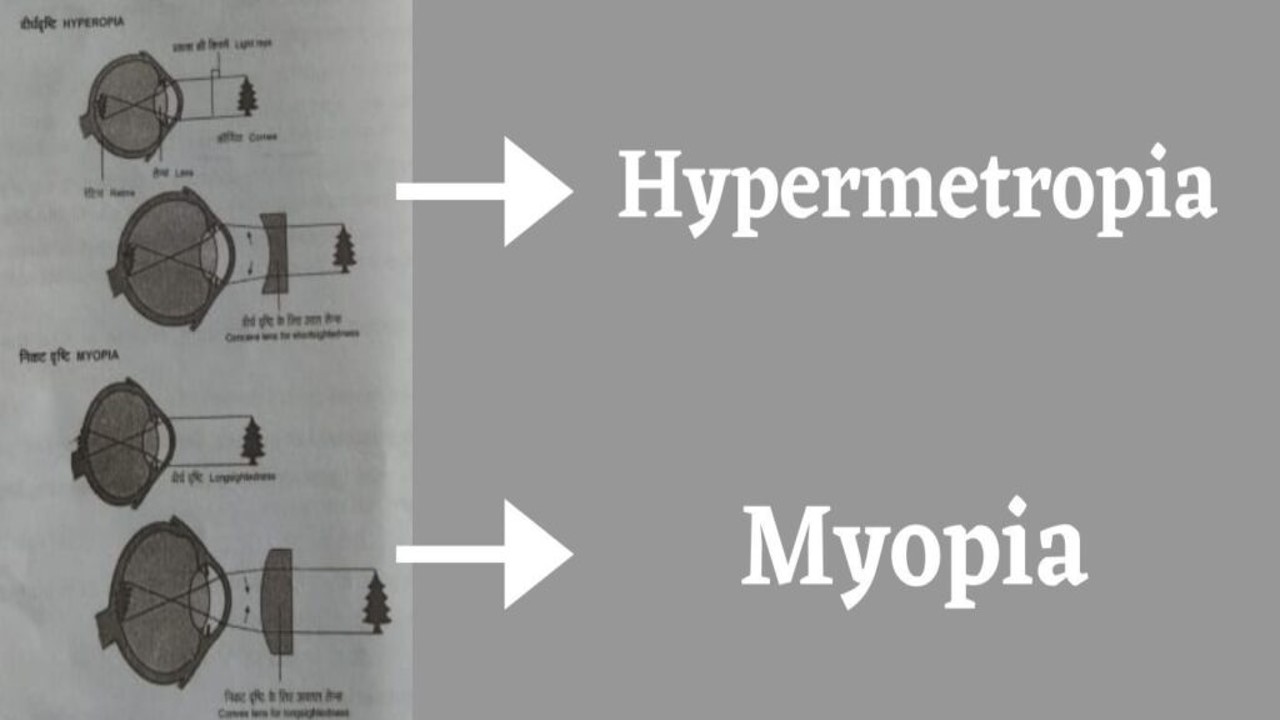Vision impairment is a term related to an eye disease that includes various defects related to the eye’s vision. Generally, based on the disturbance of the vision of the eye, the defects of vision are divided into three parts, which are as follows –
- myopia
- Farsightedness
- Presbyopia
What is myopia?
Contents
- 1 What is myopia?
- 1.1 Causes of Myopia
- 1.2 Symptoms of Myopia
- 1.3 Remedy of Prevention of nearsightedness
- 1.4 What is Hypermetropia?
- 1.5 Causes of farsightedness
- 1.6 Symptoms of Hypermetropia
- 1.7 Remedy of Prevention of farsightedness
- 1.8 What is Presbyopia?
- 1.9 Causes of Presbyopia
- 1.10 Symptoms of Presbyopia
- 1.11 Remedy of Prevention of shortsightedness
- 2 👁️🗨️ 1. Myopia (Nearsightedness)
- 3 👁️🗨️ 2. Hyperopia (Farsightedness)
- 4 👁️🗨️ 3. Presbyopia (Age-related Farsightedness)
- 5 🧾 Summary Table:
What is myopia – When the near object is clearly visible from the eye and the distant object is not clearly visible, then such defect of vision of the eye is called nearsightedness. This is a common eye disease. This too, like farsightedness, usually occurs only after 40 years. This often happens in cataract disease as well. In this also, like farsightedness, people get work by wearing glasses.

Causes of Myopia
Causes of nearsightedness – In this defect, the image of the object is formed in front of the retina of the eye but in order to see clearly the image of the object must be formed on the retina of the eye. Because of this, it becomes a defect. The reason for such a phenomenon occurring inside the eye is the enlargement of the eyeball, lens or cornea.
Symptoms of Myopia
The symptoms of nearsightedness are following –
- Doesn’t seeing distant objects well
- See near object clearly
Remedy of Prevention of nearsightedness
Remedy of Prevention of nearsightedness are following –
- Do not work continuously with the eyes.
- Give rest for an hour for a while.
- Wash your eyes with clean water two to three times a day.
- Be sure to do eye exercises.
- Eat a nutritious diet or take a multivitamin and mineral tablet daily.
What is Hypermetropia?
What is farsightedness – In this defect, distant object can be seen well with the eye, but the object close to the eye is not visible well. This disease usually occurs in 90% of the people after 40 years. In this, people are not able to read small letters, for which they need glasses. In this also people get work by wearing glasses like nearsightedness.
Causes of farsightedness
Causes of farsightedness – The main reason for this is the shortening of the eyeball of the eye. Due to the shortening of the eyeball of the eye, the image of the object is formed behind the retina of the eye, due to which it is not visible clearly. In order to be clearly visible to the eye, the image of the object must be formed on the retina of the eye.
Symptoms of Hypermetropia
- To see distant objects well.
- The nearby object is not visible.
- Headache and eye pain from reading
Remedy of Prevention of farsightedness
- Do not work continuously with the eyes.
- Give rest for an hour for a while.
- Wash your eyes with clean water two to three times a day.
- Be sure to do eye exercises.
- Eat a nutritious diet or take a multivitamin and mineral tablet daily.
What is Presbyopia?
What is presbyopia – the word presbyopia means – old eyes. In old age, it becomes difficult to read books, newspapers etc. This is called shortsightedness.
Causes of Presbyopia
Causes of shortsightedness – the ciliary muscles become weak in old age. Simultaneously the lens gets bigger. Due to this, the ciliary muscles are not able to rapidly adjust the rays of light going from the object, so that the image of the object is not formed on the retina. In this, the object is not clearly visible.
Symptoms of Presbyopia
- In the beginning, while reading the printed book etc., the person makes it very close to the eye.
- After reading, sometimes a person is unable to see distant objects for some time. This is because the adjustment ability of the eye needs rest.
- In the evening, when tired or in low light, the person has difficulty in reading.
- Nearsightedness, farsightedness and those who have astigmatism, there may be slight visual impairment in all these three conditions.
- In this, the ability to see is restored with the lens.
- Reading glasses are fitted for poor near vision.
- Distance vision glasses are installed for weak distant vision.
- Bifocal glasses are fitted when both far and near vision are weak.
- In this, the upper part of the mirror is used to keep farsighted and the lower part is used to keep the near vision right.
- With increasing age, minor vision impairment also increases till the age of 65 years. After 65 years of age, the visual impairment stops.
Remedy of Prevention of shortsightedness
- Do not work continuously with the eyes.
- Give rest for an hour for a while.
- Wash your eyes with clean water two to three times a day.
- Be sure to do eye exercises.
- Eat a nutritious diet or take a multivitamin and mineral tablet daily.
Vision Impairments – Myopia, Hyperopia, and Presbyopia Explained Simply
These three are common refractive errors that affect how clearly we see objects at various distances.
👁️🗨️ 1. Myopia (Nearsightedness)
🔍 What is it?
-
Difficulty seeing distant objects clearly.
-
Near objects are clear, but far objects are blurry.
🧠 Why it happens:
-
Eyeball is too long, or the cornea is too curved.
-
Light focuses in front of the retina instead of on it.
📚 Symptoms:
-
Squinting to see far objects
-
Headaches or eye strain
-
Trouble seeing the board in class or road signs
👓 Correction:
-
Concave (minus) lenses
-
Contact lenses or LASIK surgery
👁️🗨️ 2. Hyperopia (Farsightedness)
🔍 What is it?
-
Difficulty seeing near objects clearly.
-
Distant objects are clearer than close ones.
🧠 Why it happens:
-
Eyeball is too short, or the cornea is too flat.
-
Light focuses behind the retina.
📚 Symptoms:
-
Eye strain when reading or working up close
-
Blurry vision at close range
-
Headaches, especially after close work
👓 Correction:
-
Convex (plus) lenses
-
Contact lenses or surgery
🔍 What is it?
-
A natural part of aging; difficulty focusing on close objects, especially reading.
🧠 Why it happens:
-
The eye lens loses flexibility with age.
-
Common after age 40.
📚 Symptoms:
-
Needing to hold reading material farther away
-
Blurred vision at normal reading distance
-
Eye fatigue or headaches during close work
👓 Correction:
-
Reading glasses
-
Bifocals, progressive lenses, or multifocal contacts
🧾 Summary Table:
| Condition | See Clearly | Problem With | Cause | Lens Type |
|---|---|---|---|---|
| Myopia | Near | Far vision | Long eye / strong cornea | Concave (-) |
| Hyperopia | Far | Near vision | Short eye / flat cornea | Convex (+) |
| Presbyopia | Variable | Age-related near | Lens stiffens with age | Reading/Bifocal |
Would you like this summarized in Hindi, or need diagrams to understand the differences better?

